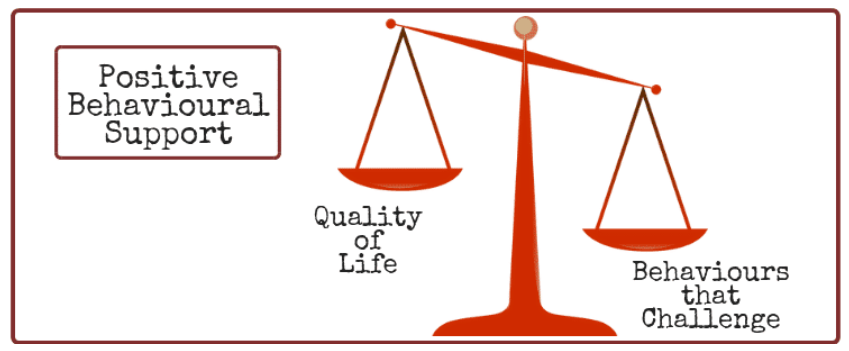
Positive behavourial support
See the video below for an introduction to Positive Behavioural Support.
If you are unable to access the embedded video, click the following link – Positive Behavioural Support (YouTube)
Positive Behavioural Support (PBS) is an ethical, tried and tested way of supporting people who are at risk of behaviours that challenge. It is person-centred and focusses on improving the quality of life of people who need support, such as those with mental health difficulties, dementia, acquired brain injury, learning disabilities, older people and vulnerable children. The overall goal is to enhance a person’s quality of life, thus reducing the likelihood of behaviours that challenge occurring in the first place (PBS Academy, 2015).
PBS offers a framework for developing an understanding of behaviour and is based on the assessment of the context in which the behaviour occurs, creating hypotheses that are used to create a plan. It focuses on what services, carers and professionals need to do to meet individual people’s needs in the best way possible.

PBS is values led and ensures that people being supported have:
- The same human rights as other people.
- The same opportunities as other people.
- To be treated fairly.
- To be treated with compassion, kindness, respect and dignity.
Understanding behaviour: Everything we do has a purpose. Understanding this is a key part of PBS. The starting point is to get a clear picture of what is going on, how the environment is coped with and how needs are met. This allows the unique needs, aspirations, experiences and strengths of an individual to be recognised.
Understanding the environment: Everything we do is affected by our environment. This includes the people we interact with, the support we have, where we live and how we spend our time. Understanding the influence of our environment and improving it is part of PBS.
PBS interventions: There are three stages to PBS interventions.
Primary Strategies
This is everything that is put in place to reduce the likelihood of the behaviour happening and improving quality of life. This could include changing the environment, providing new opportunities and acquiring new skills.
Secondary strategies
These are plans for what to do if the primary strategies do not work and behaviour starts to escalate. These plans might include using calming approaches, changing the environment or distraction.
Tertiary strategies
These are plans to manage a response to an incident of behaviour that challenges. They aim to take control of the situation and minimise the risk to the person and others.
Understanding the misunderstanding
These are ways to help manage the period following an incident and to mitigate the psychological and emotional fallout from the inevitable distress that these cause. They aim to help re-establish the person’s peace of mind and self-esteem, to begin to repair the damaged relationship between patient and staff member and to minimise the likelihood of similar incidents.
These might be summarised as: How to help with putting things together again by … ‘Understanding the Misunderstanding’?